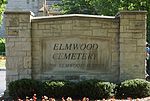Engine House No. 18 (Detroit)
1892 establishments in MichiganBuildings and structures in DetroitDefunct fire stations in MichiganDetroit Fire DepartmentFire stations completed in 1892 ... and 3 more
Fire stations on the National Register of Historic Places in MichiganMichigan State Historic Sites in Wayne County, MichiganNational Register of Historic Places in Detroit

The Engine House No. 18 is a fire station located at 3812 Mt. Elliott Avenue in Detroit, Michigan. It is also known as Engine Company No. 18 Fire Station. It is the third oldest existing (and was the oldest operating when closed in 2012) fire station in Detroit. The station was listed on the National Register of Historic Places in 1995.
Excerpt from the Wikipedia article Engine House No. 18 (Detroit) (License: CC BY-SA 3.0, Authors, Images).Engine House No. 18 (Detroit)
Mount Elliott Street, Detroit
Geographical coordinates (GPS) Address Nearby Places Show on map
Geographical coordinates (GPS)
| Latitude | Longitude |
|---|---|
| N 42.363055555556 ° | E -83.0225 ° |
Address
Mount Elliott Street 3738
48207 Detroit
Michigan, United States
Open on Google Maps







